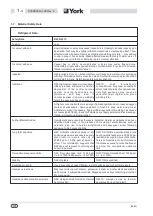
1.7
Material Safety Data
Refrigerant Data:
Safety Data
R22, R407C
Toxicity
Low.
In contact with skin
Liquid splashes or spray may cause freeze burns. Unlikely to be hazardous by skin
absorption. R22 may be slightly irritant and liquid has a degreasing effect. Thaw
affected areas with water. Remove contaminated clothing carefully — may adhere
to skin in case of freeze burns. Wash affected areas with plenty of warm water. If
symptoms occur (irritation or blistering) obtain medical attention.
In contact with eyes
Vapour has no effect. Liquid splashes or spray may cause freeze burns.
Immediately irrigate with eyewash solution or clean water for at least 10 minutes.
Obtain immediate medical attention.
Ingested
Highly unlikely to occur — but should this occur freeze burn will occur. Do not induce
vomiting. Provided patient is conscious, wash mouth with water and give about 250
ml (0.5 pint) to drink. Obtain immediate medical attention.
Inhalation
R22: High levels of vapour concentration
initially produce stimulation and then
depression of the central nervous
system causing headaches and
giddiness
and
may
lead
to
unconsciousness. Can prove suddenly
fatal if the exposure has been severe.
R407C:
High
atmospheric
concentrations may lead anaesthetic
effect, including loss of consciousness.
Very high exposures may cause an
abnormal heart rhythm and prove
suddenly fatal.
At higher concentration there is a danger from asphyxiation due to reduced oxygen
content of atmosphere. Remove patient to fresh air, keep warm and at rest.
Administer oxygen if necessary. Apply artificial respiration if breathing has ceased
or shows signs of failing. In event of cardiac arrest apply external cardiac massage.
Obtain immediate medical attention.
Further Medical Advice
Symptomatic and supportive therapy is indicated. Cardiac sensitisation has been
described which may, in the presence of circulating catecholamines such as
adrenalin, give rise to cardiac arrhythmias and subsequent arrest following
exposure to high concentrations.
Long term exposure
R22: A lifetime inhalation study in rats
and mice give a small excess in salivary
gland tumours in male rats only at
50,000 ppm. 10,000 ppm showed no
effect. This information suggests that
R22 does not represent a carcinogenic
hazard to humans.
R407C: A lifetime inhalation study in rats
has shown that exposure to 50,000 ppm
resulted in benign tumours of the testis.
This is not considered to be of relevance
to humans exposed to concentrations at
or below the occupational exposure
limit.
Occupational exposure limits
R22: Recommended limit: 1000 ppm
v/v - 8 hr TWA 1250 ppm v/v - 12 hr TWA.
R407C: Recommended limit: 1000 ppm
v/v - 8 hr TWA.
Stability
R22: Unstable.
R407C: Not specified.
Conditions to avoid
Use in presence of naked flames, red hot surfaces and high moisture levels.
Hazardous reactions
May react violently with sodium, potassium, barium and other alkali and alkaline
earth metals. Incompatible materials: Magnesium and alloys containing more then
2% magnesium.
Hazardous decomposition products
R22: Halogen acids formed by thermal
decomposition.
R407C: Halogen acids by thermal
decomposition and hydrolysis.
(09/03)
1
-
4
035B09012-100 Rev. 4
Содержание YCAA B 120
Страница 2: ......
Страница 16: ...This Page Left Intentionally Blank 09 03 2 6 035B09012 100 Rev 4 ...
Страница 28: ...This Page Left Intentionally Blank 09 03 4 10 035B09012 100 Rev 4 ...
Страница 36: ...Page Left Intentionally Blank 09 03 6 6 035B09012 100 Rev 4 ...
Страница 40: ...Page Left Intentionally Blank 09 03 7 4 035B09012 100 Rev 4 ...
Страница 68: ...Notes 09 03 11 2 035B09012 100 Rev 4 ...
Страница 69: ...Notes 09 03 035B09012 100 Rev 4 11 3 ...
Страница 70: ...Notes 09 03 11 4 035B09012 100 Rev 4 ...









































